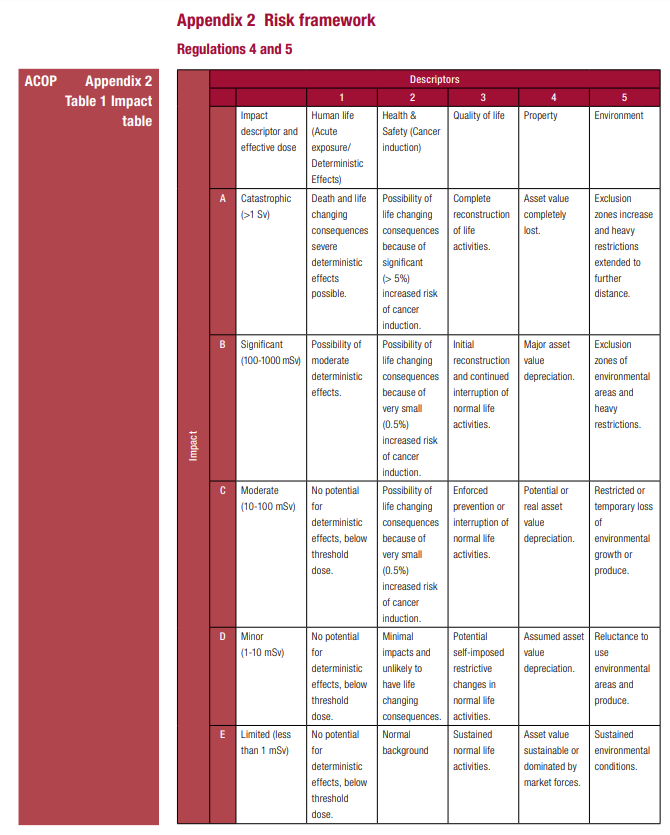Radiation Emergency and Emergency Planning Regulation in the UK
Radiation Emergency
"Radiation Emergency" is the term applied to situations where it is necessary to respond quickly to protect human life, health and safety, quality of life, property or the environment from a situation involving the use of radioactivity.
Radiation emergencies include:
- The explosion of a nuclear weapon or an improvised nuclear device.
- A Dirty Bomb or a Radiological Dispersal Device - which uses conventional explosives to disperse radioactive material
- A Radiological Exposure Device - where a strong radiation source is hidden in a public place
- A nuclear power plant accident
- A transport accident - where a shipment of radioactivie material leaks
- Occupantional accident - An accidental overdose of radiation at a health care, research or manufacturing site.
A radiation emergency is defined by the REPPIR regulations (REPPIR) as ''a non-routine situation or
event arising from work with ionising radiation that necessitates prompt action to mitigate the serious consequences—''
- of a hazard resulting from that situation or event
- of a perceived risk arising from such a hazard; or
- to any one or more of—
- human life;
- health and safety;
- quality of life;
- property;
- the environment;
Preparedness in the UK
If there were to be a radiation emergency you would hope that the authorities would react quickly, understand the situation, provide clear and certain advice to the public about how to protect themselves and provide help to those unable to take the required protective actions without assistance. There are a number of regulations that place responsibilites on certain organisations with the intent that any radiation emergency will be met with a competent and practiced response.
The Civil Contingencies Act provides the main framework for UK risk assessment and emergency preparedness and response.
REPPIR provides the framework for emergency planning and response for sites with significant inventories of radioactive material.
REPPIR Regulation 4 requires the operator of a site to carry out and write a report of an evaluation to identify all hazards from their work with ionising radiation that have the potential to cause a radiation emergency. Having identified these hazards, the operator is then required to make arrangements to prevent any radiation emergency and to limit the consequences of any such emergency that occurs.
Regulation 5 requires the operator to "evaluate a full range of consequences of such a radiation emergency" i.e. to understand and report the scenarios where a radiation emergency was possible and the full range of potential consequences that might require prompt actions to protect the public and the environment.
Regulation 7 requires this information to be summarised and sent to the local authority and regulators with advice about how far downwind of the site prompt protective actions may be required to protect the public, how quickly the situation will develop and how long it may last.
Regulation 8 requires the local authority to use this information to determine the extent of any Detailed Emergency Planning Zone and Regulation 11 requires that, where there is either a detailed emergency planning zone, an outline planning zone, or both, the local authority must prepare an adequate off-site emergency plan to mitigate the consequences of a radiation emergency outside the operator’s premises.
Regulation 21 requires the local authority, in cooperation with the operator, to ensure that prior information is provided to the public in the detailed emergency planning zone where appropriate and is accessible to the public in an outline planning zone.
Guidance tells us that:67 The term radiation emergency is central to the interpretation of the main requirements of REPPIR as it encompasses all events which could potentially lead to an emergency for which the response necessitates the level of planning that REPPIR commands.
68 A non-routine situation or event could be as a consequence of a deviation in normal activity of persons, equipment, systems, installations, or facilities, or due to an external factor. Examples of initiating events are plant and equipment failures, breakdown of administrative arrangements, human error, extreme weather or seismic activity.
69 For the purposes of REPPIR, in addition to consideration of perceived risks, all events that may result in an annual effective radiation dose of 1 mSv or more to one or more person(s) off site over a period of one year following the event are considered to be a radiation emergency.
This statement equates the rather low dose of 1 mSv over a year to "serious consequence" which is questionable particularly as there is no requirement for a detailed off-site plan for doses below 7.5 mSv (REPPIR, Appendix 2, Figure 7).
Appendix 2 of REPPIR-19 The risk framework provides a table that shows the implications of radiation over 5 decades against each of the descriptors in the regulation.
